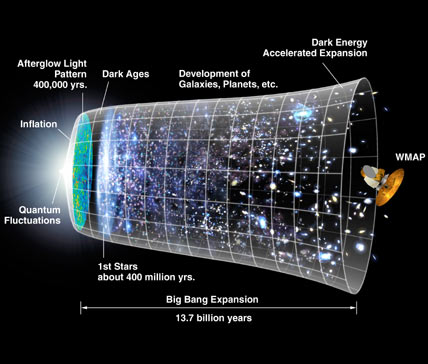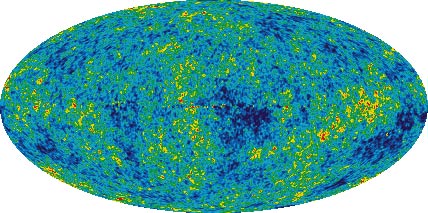In the May 2008 issue of Sky & Telescope (page 18), we describe how astronomers are decoding the oldest light in the universe: the cosmic microwave background (CMB) radiation. The CMB tells what the universe was like some 380,000 years after the Big Bang. Before that time, the primordial gas was so hot that electrons floated freely, unbound to atomic nuclei. Photons could travel only a few centimeters before scattering off these electrons. The universe was opaque, like a dense fog.
By 380,000 years after its birth, the cosmos had expanded and cooled to 2,900 kelvin (4,800°F), a temperature at which electrons could combine with nuclei (mostly protons) to form neutral atoms (mostly hydrogen). During this period of recombination, the fog lifted, and for the first time CMB photons could travel virtually unimpeded across the universe. Sometimes astronomers describe this light as coming from the surface of last scattering.

This symbolic representation shows the evolution of the universe over 13.7 billion years. The far left depicts the Big Bang, the earliest moment we can yet probe, when an extremely brief moment of "inflation" produced a burst of exponential growth in the universe. (Size is symbolized by the vertical extent in this graphic.) For the next several billion years, the expansion of the universe gradually slowed down as the matter in the universe pulled on itself via gravity. More recently, the expansion has begun to speed up a bit as the repulsive effect of dark energy has come to dominate the expansion of the universe. Today's microwave background was emitted 380,000 years after inflation, when the stuff of the universe first became transparent. The radiation has traversed the universe largely unimpeded since then. The conditions of earlier times are imprinted on this radiation; it also forms a backlight for later developments of the universe. Click image for larger view.
NASA / WMAP Science Team
Cosmic expansion has redshifted, or stretched the wavelengths, of this light into the microwave part of the electromagnetic spectrum. In 1965 Arno Penzias and Robert Wilson first recorded the faint hiss of microwaves coming from all directions. Because the existence of this radiation was such a firm prediction of the Big Bang cosmology, most scientists quickly embraced it.
In our S&T article, we explain how subsequent observations of the CMB, especially those from NASA's Cosmic Background Explorer (COBE) and Wilkinson Microwave Anisotropy Probe (WMAP) satellites, have bolstered astronomers' confidence that the Big Bang theory is correct, at least in its broad strokes, and that our universe really is expanding from an unfathomably hot, dense early state.
Ironically, WMAP's latest data release, on March 7, 2008, occurred while S&T's May issue, with our article and an animated postcard presenting data from WMAP's 2006 release, was at the printer!
For the first time, WMAP astronomers now report evidence that a sea of elementary particles permeates our universe: a cosmic neutrino background left over from right after the Big Bang. Neutrinos are virtually massless particles that zip around at nearly the speed of light and barely interact with atoms or light. These elusive particles were forged in the universe’s early moments, when enormous numbers of matter and antimatter particles annihilated one another in a titanic burst of energy. Millions of neutrinos pass through your hand every second. Despite their huge numbers, though, neutrinos are relatively unimportant in the modern-day universe because they've lost energy compared with atomic matter and dark matter.
Cosmic neutrinos comprised more than 10% of the energy density in the early universe, so they had a modest affect on its early expansion. They also influenced the microwave signal at small angular scales — tweaking the location and shape of the "third acoustic peak" of the CMB spectrum. (We explain acoustic peaks in our article, which includes a fine infographic by NASA's Britt Griswold and S&T's Casey Reed.) It took five years of high-quality data to tease out this imprint because it's right at the limit of WMAP’s resolution.
With five years of WMAP data plus observations from numerous ground-based CMB experiments, astronomers have now refined the ingredients in the cosmic recipe. The WMAP team reports that atoms make up 4.6% ± 0.2%, cold dark matter makes up 23.3% ± 1.3%, dark energy makes up 72.1% ± 1.5%, and neutrinos and photons each make up around 0.03% of the universe’s energy content. The microwaves that WMAP now sees come from an epoch when the universe was only 380,000 years old, when atoms made up 12% of the universe, dark matter made up 63%, photons made up 15%, neutrinos made up 10%, and dark energy was negligible.
The new WMAP data also shed light on the end of the so-called Dark Age, when the first generation of stars heated and reionized intergalactic hydrogen gas, once again liberating electrons from atomic nuclei. These free electrons scattered about 10% of the CMB's photons, imparting some polarization to the light. Most of the scattering would have taken place in the universe's first billion years, when the density of electrons was much greater and the probability of scattering was much higher than it is today. WMAP's measurements of CMB polarization thus provide an indirect measurement of the density of free electrons produced by the first stars. These observations suggest that reionization began about 400 million years after the Big Bang and lasted until the universe was about 1 billion years old.
The five-year WMAP observations are the world's best data for examining "inflation," the exponential burst of growth in the universe's first trillionth of a second, when gravitational waves — ripples in space itself — may have been created. These ripples are distinct from the gravitational variations associated with matter-density fluctuations, which are also produced during inflation. The new WMAP results place the tightest limits yet on how strong the gravitational waves could have been: less than 20% of the variation due to density fluctuations. If inflation is a byproduct of the breakdown of Grand Unified Theory, as many cosmologists think, then the gravitational-wave strength should exceed about 1% of the density signal, so the upcoming generation of CMB experiments have a real shot at measuring this signal and teaching us more about the cosmos's first trillionth of a second.

Tiny temperature irregularities in the cosmic microwave background are mapped on this full-sky projection. This is the new the 5-year WMAP data. The average temperature is 2.725 kelvin (degrees above absolute zero; equivalent to –270° C or –455° F). The colors represent the tiny temperature deviations from this, as in a weather map. Red regions are warmer and blue regions are colder by only about 0.0002 degrees. Click image for larger view.
NASA / WMAP Science Team
Here's some additional information about how certain aspects of the CMB clue astronomers in to some of the universe's fundamental properties. (Much of what follows may be unintelligible if you haven't read the magazine article!)
Baryon Acoustic Oscillations and Dark Energy
The sound waves that left their distinctive imprint on the CMB also imparted a characteristic signature in the clustering of galaxies. When the sound waves "froze out" at recombination, both the photon gas and the baryon gas had regions of enhanced density with a spacing set by the first acoustic peak. Afterward, while the photons were streaming across the universe, the baryons were left to condense into galaxies and clusters, spurred on by dark matter. As this process unfolded, the clustering pattern retained some memory of the initial baryon acoustic oscillations. In 2005 the Sloan Digital Sky Survey first observed the signature of these oscillations in the galaxy distribution (S&T: May 2005, page 18). Since this scale expands with the overall expansion of the universe, careful measurements of the galaxy distribution as a function of time can provide a direct measurement of the universe's expansion history. This, in turn, can help cosmologists pin down the nature of the so-called dark energy that's causing the expansion to accelerate.
The Age of the Universe
How does WMAP data enable cosmologists to determine that the age of the universe is 13.7 billion years, with an uncertainty of less than 1%? The key to this precision is that by knowing the composition of matter and energy density in the universe, which WMAP provides, we can use Einstein's general theory of relativity to compute how fast the universe has been expanding in the past. With that information, we can turn the clock back and determine when the universe had "zero" size, according to Einstein's equations. The time between then and now is the age of the universe.
There's one caveat to keep in mind that affects the certainty of the age determination: We assume that the universe is flat, which is well supported by WMAP and other data. If we relax this assumption within the allowed range, the uncertainty in the age increases to a bit over 2%. But theorists have long known that a nearly flat universe is very difficult to produce, whereas inflation theory (which says that the universe underwent a brief period of exponential expansion in its first fraction of a second) naturally predicts a flat universe.
Big Bang Nucleosynthesis
The term nucleosynthesis refers to the formation of heavier elements — atomic nuclei with many protons and neutrons — via the fusion of lighter elements. The Big Bang theory predicts that the early universe was a very hot place. One second after the Big Bang, the temperature of the universe was roughly 10 billion degrees, and space was filled with a sea of neutrons, protons, electrons, antielectrons (positrons), photons, and neutrinos. As the universe cooled, the neutrons either decayed into protons and electrons or combined with protons to make deuterium (an isotope of hydrogen). During the first three minutes of the universe, most of the deuterium combined to make helium, plus trace amounts of lithium. This process of element formation in the early universe is called Big Bang nucleosynthesis (BBN), and modern BBN theory agrees with observations of the cosmic abundances of light elements.
Eyes on the Prize
Many of the scientists whose insights or discoveries form the bedrock of modern cosmology have won the Nobel Prize in physics. These include Max Planck (1918), Werner Heisenberg (1932), Arno Penzias and Robert W. Wilson (1978), and John Mather and George Smoot (2006). No doubt the list will grow in coming years.
All Things Great and Small
Cosmology has always addressed big questions, such as the origin and fate of the universe, and it's been described as the science of the very large. But now that astronomers and physicists know they need to understand the quantum mechanics of the early universe to make sense of what we see around us today, cosmology is also the science of the very small. It's really the science of everything!
Astronomer Gary Hinshaw is a member of the WMAP science team at NASA's Goddard Space Flight Center. Robert Naeye of SP Systems is senior science writer in Goddard's Astrophysics Science Division.
 0
0
Comments
You must be logged in to post a comment.